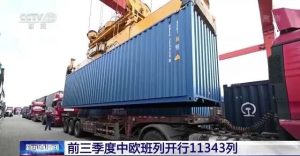
In the first three quarters of this year, China-Europe freight train transportation maintained strong growth, and continued to play a key role in stabilizing the international supply chain and boosting international cooperation against COVID-19, according to China Railway Group. In the first three quarters of this year, a total of 11,343 China-Europe freight trains have run, carrying 1.093 million TEUS of goods, up 29% and 37% respectively year-on-year, with the heavy container rate reaching 97.9%.
Since the beginning of this year, China-Europe express trains have made full use of their unique advantages in international railway combined transport, vigorously carrying goods transferred by sea and air, and the number of trains in operation has remained at a high level. A total of 11,343 trains have been opened, delivering 1.093 million TEUS of goods, up 29% and 37% respectively year-on-year, with the rate of heavy containers reaching 97.9%. In September, 1,291 China-Europe freight trains ran, carrying 127,000 TWENTY-foot equivalent units (TEUs), up 9 percent and 16 percent year-on-year respectively, continuing to play a key role in stabilizing the international supply chain and boosting international cooperation against COVID-19.
China Railway Urumqi Bureau Group Co., Ltd. has utilized the transport capacity of alashan Pass and Khorgos shorelays within the railway, optimized transport organization, refined safety measures, precise scheduling and command, enhanced the joint mobility of quasi-rail and wide rail, and maximized transport production efficiency.
China Railway Shanghai Group Co., Ltd. planned the operation frequency of china-Europe freight trains in advance, and provided 24-hour loading and unloading service for china-Europe freight trains. By the end of September, nearly 500 china-Europe freight trains (Yiwu) had run this year.
China Railway Jinan Bureau Group Co., Ltd. has actively explored the mode of “freight train + cross-border e-commerce”. The number of China-Europe freight trains in operation this year is close to the total number in operation last year.